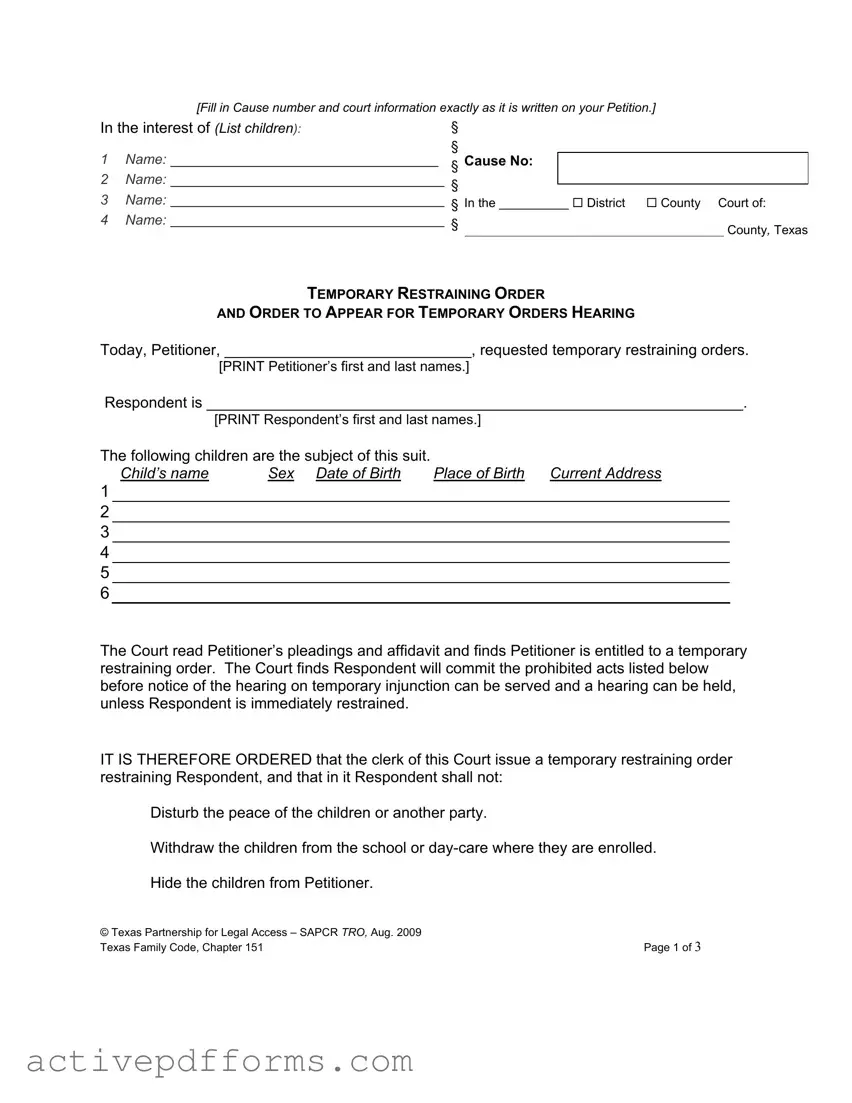[Fill in Cause number and court information exactly as it is written on your Petition.]
In the interest of (List children): |
§ |
|
|
|
|
|
|
§ |
|
|
|
1 |
Name: |
|
|
§ CAUSE NO: |
|
|
|
|
|
2 |
Name: |
|
§ |
|
|
|
|
|
|
|
3 |
Name: |
|
|
|
|
|
|
|
§ In the __________ District County Court of: |
|
|
4 |
Name: |
|
§ |
|
|
County, Texas |
|
|
|
|
|
|
|
|
|
|
|
|
|
TEMPORARY RESTRAINING ORDER
AND ORDER TO APPEAR FOR TEMPORARY ORDERS HEARING
Today, Petitioner, _____________________________, requested temporary restraining orders.
[PRINT Petitioner’s first and last names.]
Respondent is _______________________________________________________________.
|
[PRINT Respondent’s first and last names.] |
|
The following children are the subject of this suit. |
|
|
Child’s name |
Sex Date of Birth |
Place of Birth |
Current Address |
1
2
3
4
5
6
The Court read Petitioner’s pleadings and affidavit and finds Petitioner is entitled to a temporary restraining order. The Court finds Respondent will commit the prohibited acts listed below before notice of the hearing on temporary injunction can be served and a hearing can be held, unless Respondent is immediately restrained.
IT IS THEREFORE ORDERED that the clerk of this Court issue a temporary restraining order restraining Respondent, and that in it Respondent shall not:
Disturb the peace of the children or another party.
Withdraw the children from the school or day-care where they are enrolled.
Hide the children from Petitioner.
© Texas Partnership for Legal Access – SAPCR TRO, Aug. 2009 |
|
Texas Family Code, Chapter 151 |
Page 1 of 3 |
Talk badly about Petitioner or Petitioner’s family to, or around, the children.
Drink alcohol or consume controlled substances within 12 hours before or during a period of possession or access to the children.
Cancel, change, fail to pay premiums, or disturb the present level of health insurance coverage for the children.
This restraining order is effective immediately and shall continue until further order of this Court or until it expires by operation of law. This order binds Respondent, Respondent’s agents, servants, and employees; and those in active concert or participation with them who receive actual notice of this order by personal service or otherwise. No bond is required.
IT IS FURTHER ORDERED that the clerk shall issue notice to Respondent,
__________________________________________, to appear, and Respondent is ORDERED
[PRINT Respondent’s first and last names.]
to appear in person, and to bring the following:
●tax returns for the past two years,
●a written description of his or her monthly income and expenses, and
●pay stubs for the past three months.
Respondent IS ORDERED to appear with those documents before the Court in the courthouse at
________________________________________________________________________.
[PRINT the street address of the courthouse or place for hearing.]
on _____________________________________________ at _______________ __. M.
[PRINT hearing date.] |
[PRINT time.] |
The purpose of the hearing is to decide if the temporary restraining order should be made a temporary injunction while this case is pending, and to make temporary orders in the best interest of the children including but not limited to the following:
Temporary Conservatorship (custody) orders naming Petitioner:
Joint Managing Conservator, with the exclusive right to establish the children’s primary residence, (Home-Parent),
Joint Managing Conservator, noncustodial parent, (Co-Parent), Sole Managing Conservator, (Home-Parent),
Possessory Conservator, (Co-Parent),
© Texas Partnership for Legal Access – SAPCR TRO, Aug. 2009 |
|
Texas Family Code, Chapter 151 |
Page 2 of 3 |
and naming Respondent: [CHECK only one.]
Joint Managing Conservator, with the exclusive right to establish the children’s primary residence, (Home-Parent).

 Joint Managing Conservator, noncustodial parent, (Co-Parent).
Joint Managing Conservator, noncustodial parent, (Co-Parent). 
 Sole Managing Conservator, (Home-Parent).
Sole Managing Conservator, (Home-Parent).
Possessory Conservator (Co-Parent).
Child Support Orders ordering Respondent to:
pay statutory child support, health insurance premiums for the children, and half of the children’s uninsured medical expenses, private school tuition, or day-care expenses during this case.

 Residency Restrictions, limiting the children’s residence to the following geographic area: __________________________________________________________________
Residency Restrictions, limiting the children’s residence to the following geographic area: __________________________________________________________________

 Travel Restrictions, limiting Respondent from taking the children outside a geographical area defined by the Court, acting directly or with others.
Travel Restrictions, limiting Respondent from taking the children outside a geographical area defined by the Court, acting directly or with others.
Standard Visitation Orders.

 Limited Visitation Orders, denying Respondent’s access to the children, or limiting it to only supervised contact with the children.
Limited Visitation Orders, denying Respondent’s access to the children, or limiting it to only supervised contact with the children.
Other Temporary Orders Requested
_____________________________________________________________________
_____________________________________________________________________
_____________________________________________________________________
_____________________________________________________________________
IT IS FURTHER ORDERED that any authorized person eighteen years of age or older who is not a party to or interested in the outcome of this suit may serve any citation, notice, or process in this case.
SIGNED on _________________________________ at ____________________ __. M.
|
___________________________________ |
|
JUDGE PRESIDING |
© Texas Partnership for Legal Access – SAPCR TRO, Aug. 2009 |
|
Texas Family Code, Chapter 151 |
Page 3 of 3 |





 Joint Managing Conservator, noncustodial parent,
Joint Managing Conservator, noncustodial parent, 
 Sole Managing Conservator,
Sole Managing Conservator, 
 Residency Restrictions, limiting the children’s residence to the following geographic area: __________________________________________________________________
Residency Restrictions, limiting the children’s residence to the following geographic area: __________________________________________________________________
 Travel Restrictions, limiting Respondent from taking the children outside a geographical area defined by the Court, acting directly or with others.
Travel Restrictions, limiting Respondent from taking the children outside a geographical area defined by the Court, acting directly or with others.
 Limited Visitation Orders, denying Respondent’s access to the children, or limiting it to only supervised contact with the children.
Limited Visitation Orders, denying Respondent’s access to the children, or limiting it to only supervised contact with the children.